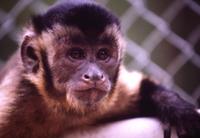22 January 2002
Perception Stored In Single Neurones
by Kate Melville
 Our perception of objects depends on our prior experience with them. What most people would call a bird is "obviously" a sparrow, sandpiper, or cockatiel for a birdwatcher. Expertise sharpens our ability to notice details. The more we learn about objects and the more familiar they become, the more details we recognize. Thus, we continue to make generalizations, but these generalizations get better and more accurate all the time.
Our perception of objects depends on our prior experience with them. What most people would call a bird is "obviously" a sparrow, sandpiper, or cockatiel for a birdwatcher. Expertise sharpens our ability to notice details. The more we learn about objects and the more familiar they become, the more details we recognize. Thus, we continue to make generalizations, but these generalizations get better and more accurate all the time.
A research group at the Max Planck Institute for Biological Cybernetics has studied what happens in the brain when we familiarize ourselves with objects. To do this they first taught rhesus monkeys to categorize objects according to specific features. Monkeys are ideal subjects for such experiments, for they are able to master a variety of visual categorization tasks and the organization of their visual system is strikingly similar to that of humans.
While the T�bingen monkeys were "working" the scientists observed the activity of neurones in a special area of the brain called the "inferior temporal cortex" (ITC). Today we know that this area is responsible for the recognition of objects. The researchers asked how a special training program for object categorization would affect how these objects are represented in the brain. To do this they showed the monkeys a series of line drawings of faces on a computer monitor. (In another set of experiments the monkeys learned to recognize fish.) The faces consisted of an outline of the head and a total of four variable features: eye height, eye separation, nose length and mouth height. Each of these features could appear in one of three different variants: the nose, for example, could be short, medium or long. The monkeys were trained to distinguish between two different kinds of faces. In one category the eyes were low and widely spaced. In the other category they were high and narrow. Thus, the two features "eye separation" and "eye height" served to define the categories. The other two features, nose length and mouth height, varied randomly and were irrelevant for categorization.
In these tests the Max Planck scientists determined that single neurones in a particular brain region reacted to the two features "eye height" and "eye separation." The activity of these neurones was substantially stronger when these two "relevant" features fit the category in question. The other two features "nose length" and "mouth height" provoked only an indifferent reaction. In other words, these specialized neurones had learned to distinguish between the two categories. Rather than simply representing the presence of a specific object or features, they convey detailed information about the features that are diagnostic for the two categories.
The researchers were also able to show that the monkey brains actually use the features learned in this experiment to recognize objects. After training the animals were able to identify "matching" faces, i.e. faces with similar features.
The T�bingen group concludes that there are apparently single neurones that sharpen our perception when they are trained to respond to categories. By making generalizations our brain is able to encode and interpret what we see around us.
